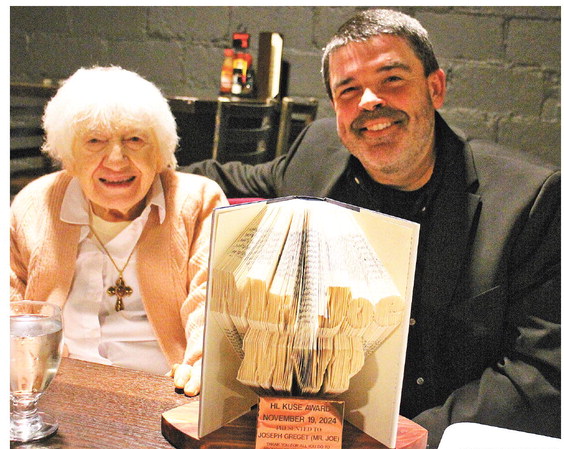The Table


Sally Rasmussen
The Cailleach
I was listening to storyteller Tracy Chipman (tracychipman. net) tell stories of the Cailleach, an ancient feminine personification of winter. Since all us storytellers are borrowers, I was soon re-imagining one of the tales she told.
The old woman swayed from side to side at her loom as she cast the shuttle with a soft whir. She bowed forward and back again to pull the beater in a quick thumpthump. Her feet danced across the treadles, the clatter of the harnesses answering the pressing and lifting of each foot.
She was not weaving cloth today, but piecing together remnants of previous work. A funeral suit had left behind black broadcloth that she cut into narrow strips to draw over and under the binding threads of the warp. Deep scarlet from the cloak of a holy man whose virtue lay in not having annoyed her. The brilliant white of her own belted wrap. A fine golden worsted that made a shawl for her young friend--a ridiculous creature whom she loved in her harsh sort of way.
Many days she had worked to create the wild and fierce design of the tapestry that slowly stretched out before her and wound around the back beam of her loom. She wove together songs and sighs and stories while winter storms darkened the days and snow drifted around her cabin in the forest. She wove endurance into the fabric and sacrifice and struggle while the coyotes hunted and yipped in the bright moonlight.
Finally, the old woman felt the last measure of the knowing that was hers to impart flow through her fingers as the raven rose from a bough of the white pine outside her door, and a glittering cascade of fresh snow fell upon the ground.
She rose from the wooden bench and cut her work loose. She unwound it from the beam and laid it on the bench in a few loose folds.
She straightened her back and clomped over to the door, pushing it open to enter the larger room of her cabin. Her eyes focused on the iron pot and heap of vegetables on the table, while her left hand trailed behind her to pull the door to the loom shut. She did not notice that the door did not latch behind her. But the cat who rose up from his place by the fire noticed. His eyes fastened on the gap as he stretched and brushed past the old woman.
His mistress seized a small pumpkin and began carving off the skin as the cat slipped into the other room. He sauntered to the bench at the loom, drawn by a dangling thread. The cat hooked the thread with a casual paw and pulled the tapestry to the floor in a heap.
The crone in her kitchen chopped some winter greens and dumped them into the pot with the pumpkin. She ladled cold water over the vegetables and set the pot on the stove.
The cat circled the tapestry with an air of menace, then pounced, holding it tight with his front paws and kicking at it with his back claws.
The woman opened a jar of stewed tomatoes and emptied it into the pot, leaning over the stove to let the heat soak into her bones.
The cat discovered that the fine yellow strands were the easiest to pull from the tapestry and soon threads of gold lay scattered about the small room.
Warming spices were last in the pot, and the woman breathed in the sweet and fragrant steam that rose up to bathe her face.
The cat grabbed, whirled, pounced and left his enemies dead at his feet.
The soup only required time, now. The old woman thought she might admire her work while she waited. Turning to the door, she saw the gap and heard a scrabbling sound from within.
The crone strode into the other room with the temper of whirling snow. The cat lay in a nest of tangled threads, studiously grooming his paw. The woman stood over him, a powerful coldness building within her. The cat looked up into the shrieking blizzard flashing from her slate blue eyes. He yawned and shut his eyes for a nap.
His mistress stared, then tipped her head back and laughed. She turned to the loom and re-tied the threads of the warp. She plucked up a long white strand from the floor and wove it in, swaying from side to side.


